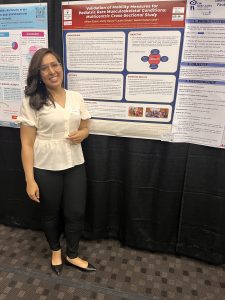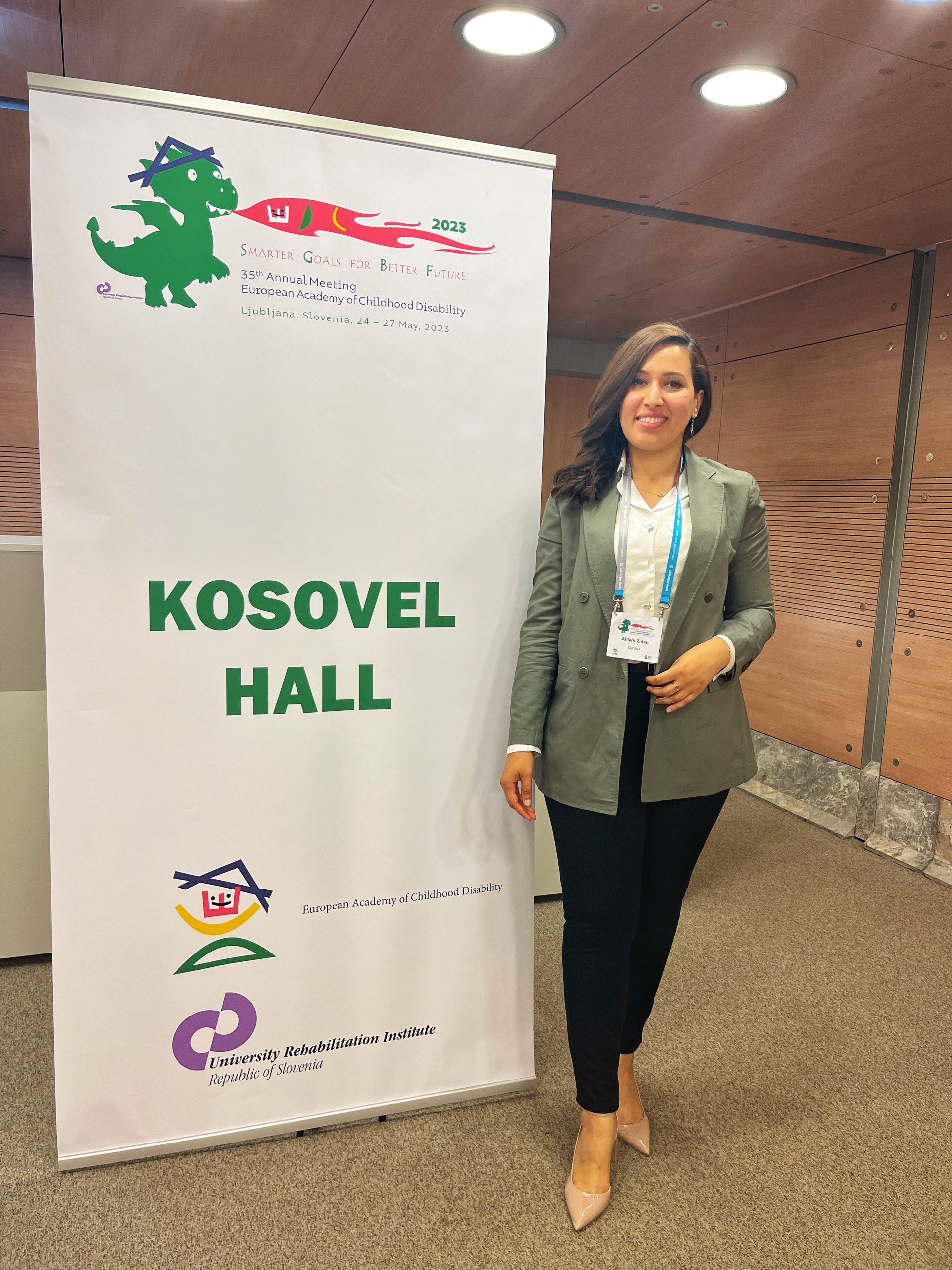Introductory information

Ahlam Zidan presenting at an international conference
Institution name/Lab: McGill University, Stakeholders Partnering for Arthrogryposis Research Client-centered Care (SPARC).
LinkedIn: linkedin.com/in/ahlam-aem-zidan
Research works interview at the EACD 2023 conference: https://youtu.be/-M8M4usKoN0
Email: ahlam.zidan@mail.mcgill.ca
- Where are you studying, and which degree you are pursuing?
I am a Ph.D. candidate studying Rehabilitation Sciences at McGill University, School of Physical and Occupational Therapy. I work under the supervision of Dr. Noemi Dahan-Oliel and Dr. Laurie Snider from McGill University, and Dr. Verity Pacey from Macquarie University in Australia. My Ph.D. research aligns with the objectives of Dr. Dahan-Oliel’s lab, “Stakeholders Partnering for Arthrogryposis Research Client-centered Care” (SPARC), which focuses on studying individuals with rare musculoskeletal conditions, specifically Arthrogryposis Multiplex Congenita (AMC). Before my current pursuit at the SPARC lab, I had the unique opportunity to collaborate with Dr. Lamontagne, where I had the chance to dive into the use of Virtual Reality in rehabilitation for the stroke population as an assessment and intervention tool. This experience significantly broadened my perspective on innovative treatment methodologies within Rehabilitation Sciences.
- What motivated you to study VR/Technologies for health?
VR, along with other rapidly evolving technologies within Rehabilitation Sciences, offers transformative solutions and precise methods to address multifaceted challenges, thereby improving the quality of healthcare delivery to a diverse patient population. What captivated me about VR is its unique capacity for immersive experiences and its ability to be tailored to a wide range of patient needs, allowing for impactful health improvements. This fascination developed into a profound passion when I began exploring telerehabilitation, which utilizes VR and other technologies to make rehabilitation services more accessible, efficient, and less intimidating for patients. Telerehabilitation using VR and different technologies ignited a passion for making rehabilitation more accessible, efficient, and less daunting for patients. Since I come originally from Libya (a large country with a relatively small population), there, consistent access to rehabilitation services over extended periods is a significant challenge due to inefficient infrastructure and limited public transportation. Learning about the potential of VR and telerehabilitation to overcome geographical and logistical barriers, and democratize access to high-quality rehabilitation care, was a truly enlightening moment for me. I recognized the immense potential of VR and gaming technologies to prevent disruptions in rehabilitation journeys by facilitating virtual assessments and treatments. Such applications hold the potential to engage patients more thoroughly, reduce perceived pain and discomfort, and provide equitable access to rehabilitation services for individuals unable to afford traditional therapy or live in remote areas. Currently, I work with children affected by rare musculoskeletal conditions. Post-Ph.D., I’m eager to delve deeper into how VR and similar technologies can enhance the rehabilitation process for these young patients while also studying their families’ experiences with this technology. As an individual who appreciates the rapid development of technology, I saw in VR a field still in its early stages but with immense potential for growth and innovation. It’s an area constantly evolving, providing endless opportunities for learning and contribution. The prospect of being part of an industry that can profoundly impact individuals’ lives and society was a powerful motivator for me.
- Tell us about your project/solution and what problem it aims to solve.
Arthrogryposis (AMC) is a group of rare congenital non-progressive conditions characterized by multiple joint contractures. AMC can significantly impact a child’s ability to attain developmental milestones and mobility, consequently impacting independence and quality of life. Currently, clinicians and researchers use mobility measures initially developed and validated for other populations, e.g., cerebral palsy. These measures have yet to be validated for AMC. Establishing the validity of mobility measures for AMC can help avoid the burden of developing novel measures and practitioner training to ensure familiarity with new measures. Valid specific-condition measures can assist clinicians and researchers in making the appropriate decisions regarding therapy and monitoring the functional progress of a child with AMC, also trusting the validity of these measures’ interpretation of a child’s mobility status.
In addition, parents have shared their concerns regarding developmental milestone attainment and mobility function in AMC and voiced the need to better understand their children’s development and mobility. Developmental delay was investigated and detected in children with other medical conditions. However, this has yet to be studied in the AMC population. Understanding the natural process of a rare disease can be challenging as studies typically are single-site, small sample size, and retrospective, thus limiting the ability to evaluate mobility and developmental status prospectively. Hence, it is necessary to determine through valid measures the association of these factors with children’s developmental milestones and mobility skills.
My multi-center cross-sectional project involves a relatively large sample size of individuals with this rare condition. The project aims to address the gaps mentioned above in the literature and estimate the extent to which mobility measures are valid for children and youths with arthrogryposis, and determine the associated factors with the attainment of developmental milestones and mobility function among a large AMC population across eight Shriners hospitals in North America.
- What makes it unique?
The uniqueness of our study lies in its unprecedented scope and inclusivity within the context of Arthrogryposis Multiplex Congenita (AMC) research. As far as we know, this is the first time a research project of such scale has been undertaken involving eight distinct hospitals spanning diverse geographical regions. Consequently, our findings are poised to offer a notably robust, varied, and representative sample for this rare disease’s research. We believe this diverse cohort will significantly enhance the validity of our findings, allowing for generalization and application to the global AMC population. Furthermore, we seek to pioneer a novel way of communicating and collaborating with families and other stakeholders. To achieve this, we intend to create easily digestible infographics designed to present complex data and results in a more accessible, engaging manner. These visual aids will serve as a platform for initiating constructive discussions, answering any questions, and addressing concerns that families may have.
What are the main challenges that you have encountered/are encountering during your studies?
One of the primary challenges I anticipate during my studies revolves around the analytical component, specifically applying advanced statistical methods. To contribute to understanding the association between different factors on developmental milestones attainment and mobility skills among AMC children, I will need to employ structural equation modeling (SEM) while analyzing the data. While SEM is a powerful tool for understanding complex causal relationships, it also presents a steep learning curve, especially for those relatively new to it. This requirement demands rigorous academic comprehension and practical application and interpretation skills, which can be quite challenging. However, despite the complexity, I view this challenge as an opportunity to enhance my analytical capabilities and enrich my research expertise.
- How do you envision your project/solution coming to fruition in the near future?
I envisage that my research findings will forge a more straightforward path for researchers, clinicians, and families alike, enhancing understanding of the developmental progress and mobility patterns in children and youths living with AMC, despite the condition’s heterogeneity. The insights gained will fuel my ongoing curiosity and passion for investigating the potential of Virtual Reality (VR) and telerehabilitation as tools to enhance the mobility and quality of life for this unique population, ensuring that the specific needs of AMC children are met in an innovative, accessible, and engaging manner. Finally, this project’s findings can help policymakers decide regarding resource allocation to meet the needs of involved stakeholders for this rare medical condition.

